Pertunjukan Musik Teatrikal “IBU” Produksi Teater Koma
Abstract
Penelitian ini membahas musik teatrikal bergaya opera dari pertunjukan musik teatrikal Ibu produksi Teater Koma. Teater Koma telah memilih berbagai komunikasi ekpresifnya, di antaranya lakon-lakon asing yang disadur, lakon-lakon Cina, lakon-lakon wayang kreatif, dan lakon-lakon realis ciptaan N. Riantiarno. Setiap produksi lakon-lakon tersebut selalu memakai musik teater yang disesuaikan dengan bentuk dan jenis lakonnya. Musik teater tersebut dapat berupa ilustrasi dan atau pengiring penuh sepanjang pertunjukan berlangsung. Untuk membahas musik teater bergaya opera ini dipilih lakon IBU yang merupakan saduran dari lakon Mother Courage and Her Children karya dramawan Jerman terkenal Bertolt Brecht. Pembahasan meminjam teori sociology of spactacles dari Guy Debord dan teori komunikasi paradigma naratif dari Walter Fisher, serta teori homofili dari Carley H. Dodd. Berdasarkan penelitian dapat disimpulkan bahwa pertunjukan Lakon Ibu merupakan teater musikal bergaya opera yang menghadirkan musik teater bersifat kolektif dalam emosi manusia, terutama karakter tokoh. Kontekstualitasnya ketimpangan masyarakat pada masa peperangan, di mana kaum pemodal selalu berada di belakangnya. Lakon IBU juga memiliki dramatik naratif yang menarik bagi penonton, sehingga mampu menciptakan komunikasi yang berdimensi homofili.
Keywords
Full Text:
PDFReferences
Baranello, M. (2016). Late Nineteenth-Century Opera and the Curse of the Effective. Cambridge Opera Journal, 28(3), 363–371. https://doi.org/http://dx.doi.org/10.1017/S0954586716000422
Cermatori, J. (2015). How to Make Sense of Music in the Theatre: A Primer for Beginners. Theatre Topics, 25(1), 67–76.
Giordano, B. L., Egermann, H., & Bresin, R. (2014). The Production and Perception of Emotionally Expressive Walking Sounds: Similarities between Musical Performance and Everyday Motor Activity. PLoS One, 9(12). https://doi.org/http://dx.doi.org/10.1371/journal.pone.0115587
Hall, E., Binney, W., & Vieceli, J. (2016). Increasing loyalty in the arts by bundling consumer benefits. Arts Marketing, 6(2), 141–165. https://doi.org/http://dx.doi.org/10.1108/AAM-01-2014-0008
Lutteken, L. (2009). Negating Opera Through Opera: Cosi fan Tutte and The Reverse of The Enlightenment. Eighteenth-Century Music, 6(2), 229–241. https://doi.org/http://dx.doi.org/10.1017/S1478570609990017
MEYER, S. C. (2008). Sound recording and the end of the Italian Lohengrin. Cambridge Opera Journal, 20(1), 1–24. https://doi.org/http://dx.doi.org/10.1017/S0954586708002383
Müllensiefen, D., Gingras, B., Musil, J., & Stewart, L. (2014). The Musicality of Non-Musicians: An Index for Assessing Musical Sophistication in the General Population. PLoS One, 9(2). https://doi.org/http://dx.doi.org/10.1371/journal.pone.0089642
Petrini, K., Crabbe, F., Sheridan, C., & Pollick, F. E. (2011). The Music of Your Emotions: Neural Substrates Involved in Detection of Emotional Correspondence between Auditory and Visual Music Actions. PLoS One, 6(4). https://doi.org/http://dx.doi.org/10.1371/journal.pone.0019165
Posner, D. N. (2010). Performance as Polemic: Tairov’s 1920 Princess Brambilla at the Moskow Kamerny Theatre. Theatre Survey, 51(1), 33–64. https://doi.org/http://dx.doi.org/10.1017/S0040557410000219
ROGERS, V. L. (2014). John Gay, Ballad Opera and the Théâtres de la foire. Eighteenth-Century Music, 11(2), 173–213. https://doi.org/http://dx.doi.org/10.1017/S1478570614000049
Seinen, N. (2009). Prokofiev’s Semyon Kotko and the melodrama of High Stalinism. Cambridge Opera Journal, 21(3), 203–236. https://doi.org/http://dx.doi.org/10.1017/S0954586710000212
Sheppard, W. A. (2009). Blurring the Boundaries: Tan Dun’s Tinte and The First Emperor. The Journal of Musicology, 26(3), 285–326. https://doi.org/http://dx.doi.org/10.1525/jm.2009.26.3.285
DOI: https://doi.org/10.24821/resital.v18i1.2443
Refbacks
- There are currently no refbacks.
This work is licensed under a Creative Commons Attribution 4.0 International License.



